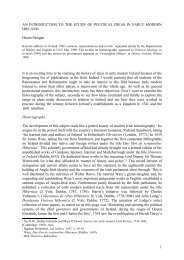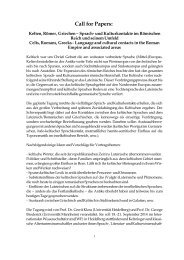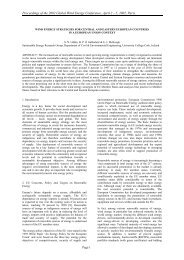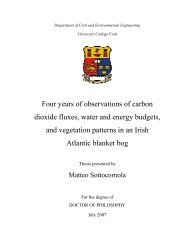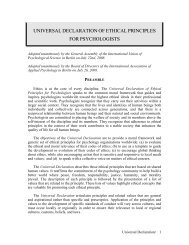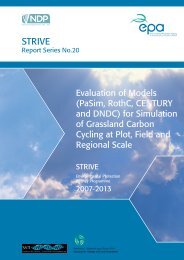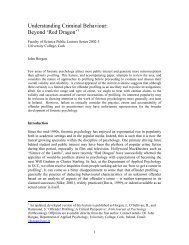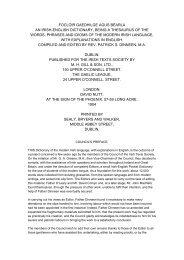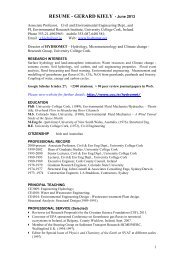Zeitschrift für celtische Philologie
Zeitschrift für celtische Philologie
Zeitschrift für celtische Philologie
Sie wollen auch ein ePaper? Erhöhen Sie die Reichweite Ihrer Titel.
YUMPU macht aus Druck-PDFs automatisch weboptimierte ePaper, die Google liebt.
Articles<br />
• Joaquín Gorrochategui, Miscellanea Iberica, 1-16<br />
• A.J. Hughes, Some aspects of the salmon in Gaelic tradition past and present, 17-28<br />
• Andrew Breeze, Ieuan ap Rhydderch and Welsh rhagman ‘game of chance’, 29-33<br />
• Herbert Pilch, Word formation in Welsh and Breton: a comparative study, 34-88<br />
• Patrick Le Besco, Le breton de Belle-Ile-En-Mer, 2e partie, 89- 258<br />
• Karel Jongeling, The nominal clause in Hebrew and Welsh, some remarks, 259-286<br />
• Kenneth Shields, Jr., Old Irish lín ‘numerus’: another Indo-European/Near Eastern<br />
connection?, 287-290<br />
• Garland Cannon, Caryl Davies, Sir William Jones (1746-94) and Lewis Morris’<br />
Celtic Remains, 291-295<br />
• Doris Edel, In memoriam Prof. Dr. Maartje Draak (1907-1995), 296- 297<br />
• Besprechungen und Anzeigen, 298-388<br />
ZCP Volume 49-50 1997<br />
Articles<br />
• D. Ellis Evans, Celticity, Celtic awareness and Celtic Studies, 1-27<br />
• Anders Ahlqvist, Sg. 199b1, 28-30<br />
• Peter Anreiter, Gallisch brigantes (Zu Marc. Emp., VIII 127), 31-42<br />
• Leszek Bednarczuk, A typological contribution to the disappearance of p in Common<br />
Celtic, 43-49<br />
• Pádraig A. Breatnach, The poet’s graveside vigil: a theme in Irish bardic elegy in<br />
the fifteenth century, 50-63<br />
• Enrico Campanile†, Die Sklaverei in der indogermanischen Gesellschaft, 64-70<br />
• Johan Corthals, Die Trennung von Finn und Gráinne, 71-91<br />
• Patrizia de Bernardo Stempel, Spuren gemeinkeltischer Kultur im Wortschatz, 92-106<br />
• Javier de Hoz, When did the Celts lose their verbal *-i?, 107-117<br />
• Christoph Alfred Dröge†, Napoleons Homer – Betrachtungen zur Ossianrezeption in<br />
Frankreich, 118-129<br />
• Ivan Duridanov, Keltische Sprachspuren in Thrakien und Mösien, 130-142<br />
• Doris Edel, Caught between history and myth? The figures of Fergus and Medb in the<br />
Táin Bó Cuailgne and related matter, 143-169<br />
• Joseph F. Eska, Allophony, Chamalières eððic, and related matters, 170-178<br />
• D. Simon Evans, The comparative adjective in Middle Welsh, 179-197<br />
• Alexander Falileyev, Cambro-Slavica, 198-203<br />
• Robert A. Fowkes, Irish and Germans on the Continent in the Middle Ages, 204-212<br />
• Thomas A. Gamkrelidze, Celtic consonantism in the light of the Glottalic theory,<br />
213-218<br />
• M.a Paz García-Bellido, Coinage and ethnicity in Celtic Spain, 219-242<br />
• William Gillies, Forms and meanings of Scottish Gaelic leugh ‘read’, 243-249<br />
• Joaquín Gorrochategui, Die Crux des Keltiberischen, 250-272<br />
• R. Geraint Gruffydd, Englynion to a mill attributed to Dafydd ap Gwilym, 273-281<br />
• Françoise le Roux & Christian-J. Guyonvarc’h, Les études celtiques de langue<br />
française et les celtisats allemands, 282-286<br />
• Hans Hartmann, Was ist ‘Wahrheit’?, 287-310<br />
• Patrick L. Henry, A note on the Brehon Law tracts of procedure and status, Cóic<br />
Conara Fugill and Uraicecht Becc, 311-219<br />
• Máire Herbert, Caithréim Cellaig: some literary and historical considerations, 320-<br />
332



